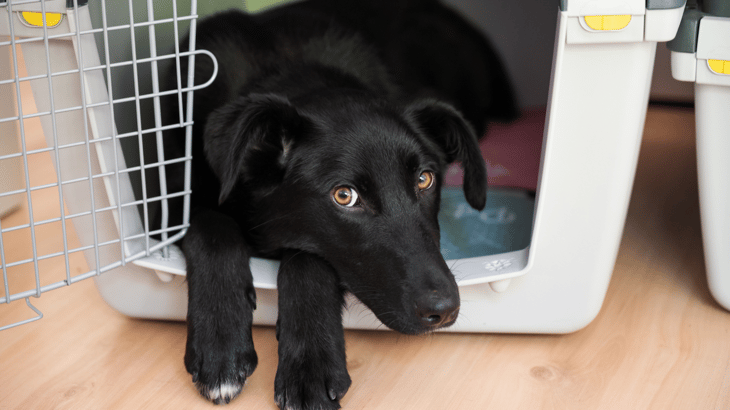Making Your Pet's Crate Comfortable and Safe
Updated on: April 10, 2024 | Author: Starwood Pet Travel

Transporting your furry friend in a crate is not only a safer option but also provides them with a higher level of comfort during travel. However, it may take some time and patience to get your dog or cat to feel at ease in a travel kennel.
Whether your pet has never encountered a crate before or has only been in one during visits to the vet, it's natural for them to be wary of anything that resembles a crate. The sight of it alone can trigger anxiety and apprehension.
Even if your dog or cat is already used to being in a crate at home, introducing them to a travel kennel can still be a challenge. But don't worry! With a little effort, you can help your pet accept and even enjoy their kennel.
Ground Transportation
If you're about to embark on a short car trip, whether it's a visit to the vet or a quick jaunt to see friends across town, it's important to keep your small pets confined for their safety and to prevent distractions while driving. Any simple crate or restraint device will do the trick.
For larger dogs, allowing them to roam freely in the car can be dangerous. In the event of a sudden stop or an accident, they can easily get hurt. To ensure their safety, consider "fencing" off the back of your vehicle or using a specially designed pet seatbelt or harness to confine them.
When it comes to longer journeys, a simple carrier or restraint is still suitable. To help your pet stay calm during the ride, provide them with their favorite toy or chew. It's also important to plan ahead and make frequent pit stops along the way. Don't forget to bring a leash, even for your kitty, and pack overnight essentials such as food and a portable dish. And remember, your furry friend can sleep comfortably in the crate during the trip.
Air Transportation
To ensure the safety and comfort of your beloved pets during air travel, the International Air Transport Association (IATA) regulates the use of travel kennels for dogs and cats. While some airlines may allow small pets to be carried onboard with you, larger pets will need to travel as cargo. However, rest assured that their space is pressurized and temperature-controlled, just like the cabin where you sit.
Meeting the IATA requirements is crucial, as guessing or assuming the correct crate size can lead to refusal from the airline if it does not meet their safety standards. Therefore, it is essential to measure your pet accurately. Once you have the measurements, you can conveniently order the appropriate kennel online or check with your local pet store or pet transport company for availability.
Travel kennel acclimation & familiarization
To provide your pet with a seamless and stress-free travel experience, it is essential to familiarize them with their travel kennel as early as possible. Allowing them ample time to adjust and feel comfortable in their carrier will create a stronger bond between them and their crate. Soon, it will become one of their most cherished possessions, just like their favorite bed, toys, or that cozy spot on your sofa or at the foot of your bed.
As a responsible pet owner, it is your role to guide them through this process. Once you know that your furry friend will be flying, make sure to purchase their new kennel. Set it up in a visible location with the door open, allowing them to explore it at their own pace. Adding their favorite blanket or one of your old t-shirts, along with familiar toys and treats, will entice them to venture inside.
If your pet is afraid of confined spaces, particularly dogs that are prone to skittishness, start by introducing them to just the bottom portion of the crate. By doing this, it will resemble a cozy bed rather than a restrictive enclosure, helping to ease their anxiety.
In addition to placing enticing items inside the kennel, engage in playful interactions with your pet around the crate. By associating the crate with positive experiences and your presence as their trusted leader, they will view it as a fun and comfortable space. "This is where my favorite things are! And my fur mom/dad is here too!"
Allow your pet to explore the kennel gradually, at their own pace, sniffing and investigating as they feel comfortable. Similar to bath time, forcing the issue will only reinforce their fear and increase stress. Instead, maintain a positive and upbeat attitude, rewarding them frequently for their interactions with the crate.
It's worth noting that airlines prohibit sedated animals from flying, so resist the urge to give your pet tranquilizers or sedatives before their flight. These substances can confuse dogs and cats, affecting their balance and increasing anxiety and the risk of injury. They can also cause cardiac or respiratory issues. If your furry companion is prone to travel anxiety, consult with your vet about holistic options such as lavender spray or other natural calming products.
Making the kennel cozy and comfortable
When preparing for travel, keep in mind that there are limits to what your pet can bring on the plane. However, there are a few items you can provide to help keep them comfortable and cozy during the journey:
- A crate pad: This soft cushion will give your pet a cozy place to rest and relax. Do note that any bedding must be less than 3 inches thick or it may be removed by the airline.
- A thin blanket, t-shirt, or towel that smells like home: Familiar scents can help soothe your pet and make them feel more at ease.
- A pee-pee pad: Just in case nature calls during the flight, this can help with any accidents.
While it's important to prioritize your pet's comfort, it's also essential to avoid putting toys, bones, or other choking hazards inside the crate. Not only is it a safety risk, but airlines typically don't allow it, and these items may be left behind. Additionally, remember that the bedding should be under 3 inches thick to comply with airline regulations. You also want to ensure that your pet doesn't get tangled in the bedding or cover their face, as this could restrict ventilation.
Subscribe to the Blog
Enjoy our content? Get them sent to your inbox!
Subscribe Now!

